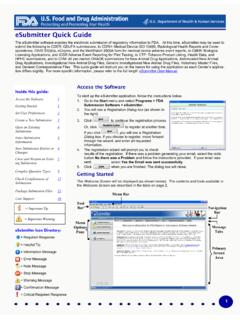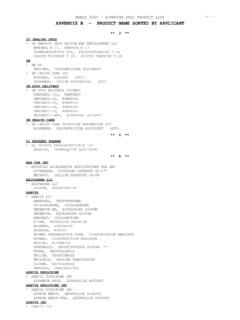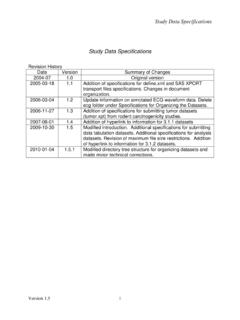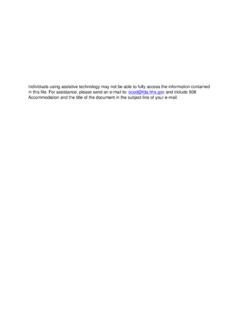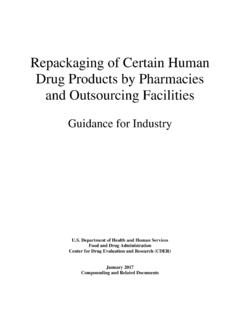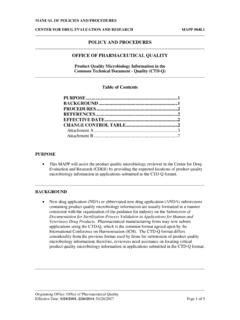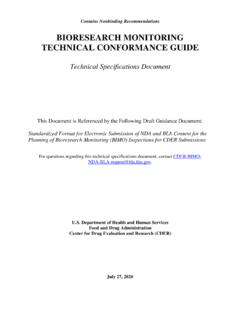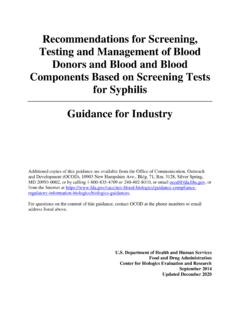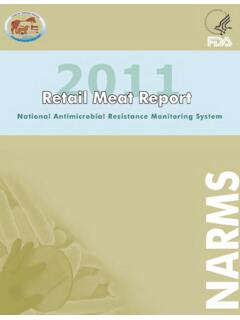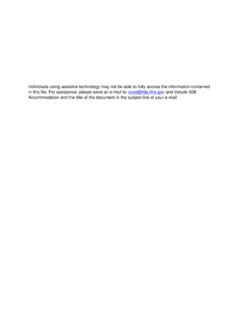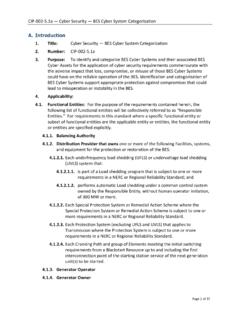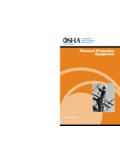Transcription of FDA's Predictive Toxicology Roadmap
1 FDA S Predictive Toxicology Roadmap FDA Predictive Toxicology ROADMAPFDA Predictive Toxicology Roadmap 1 Executive Summary The cumulative effects of globalization, rapidly evolving technologies, and emerging areas of science have created unprecedented opportunities and challenges for the Food and Drug Administration (FDA). For example, breakthroughs in many areas of science are generating new tools and methods that are being incorporated into the science of Toxicology . During the past decade, FDA scientists have taken significant steps to upgrade their Toxicology toolboxes. However, a comprehensive strategy is needed to evaluate new methodologies and technologies for their potential to expand FDA s Toxicology Predictive capabilities and to potentially reduce the use of animal testing. Acceptance of any new Toxicology methods will require sufficient convincing data as well as continuous dialogue and feedback among all relevant stakeholders from development to implementation, including qualification and acceptance by regulatory authorities.
2 To ensure that FDA continues to employ cutting-edge science to assess the safety and effectiveness of its regulated products and to leverage advances being made in Toxicology , the FDA Commissioner tasked the Agency s Toxicology Working Group with developing a Roadmap for integrating Predictive Toxicology methods into safety and risk assessments. FDA Predictive Toxicology Roadmap 2 The Toxicology Working Group recommends a six-part Roadmap for achieving identified goals. The Roadmap is summarized below and presented in more detail in the document that follows. Part One: Organizing Committee FDA has formed a senior-level Toxicology Working Group to (1) foster enhanced communication among FDA product centers and researchers and (2) leverage FDA resources to advance the integration of emerging Predictive Toxicology methods and new technologies into regulatory safety and risk assessments.
3 Specific activities will help identify areas where research is needed and may reduce duplication of efforts inside and outside FDA. Part Two: Training Continuing ongoing education in new Predictive Toxicology methods is essential for FDA regulators. Among other steps, FDA s Toxicology Working Group has established an Agency-wide education calendar of events and a Toxicology Seminar Series to introduce concepts of new Toxicology methodologies and updates in Toxicology -related topics. Part Three: Continued Communication FDA will continue to reaffirm its commitment to and support for incorporating data from newly qualified Toxicology methods into regulatory submissions and that it encourages discussions with stakeholders as part of the regulatory submission process. FDA product centers will encourage sponsors to submit a scientifically valid approach for using a new method early in the regulatory process and to engage in frequent communication with the Agency.
4 Such interactions are essential to ultimately ensuring that new Toxicology methods can be used in regulatory risk assessments. FDA Predictive Toxicology ROADMAP3 Part Four: Collaborations FDA will continue its long practice of fostering collaborations across sectors and disciplines nationally and internationally. FDA considers these types of partnerships pivotal to identifying the needs, maintaining momentum, and establishing a community to support delivery of new Predictive Toxicology methods. Part Five: Research FDA s research programs will identify data gaps and support intramural and extramural research to ensure that the most promising technologies are identified, developed, validated, and integrated into the product pipeline. Part Six: Oversight The Toxicology Working Group, with representation from each FDA center, will track the progress of these recommendations and report to the Chief Scientist annually.
5 The Working Group will also ensure transparency, fostering opportunities to share ideas and knowledge, showcase technologies, and highlight collaborations on developing and testing new methods. This six-part Roadmap , described in more detail in the document that follows, identifies FDA s critical priority areas for energizing a new and enhanced FDA engagement in transforming the development, qualification, and integration of new Toxicology methodologies and technologies into regulatory application. FDA believes that successfully implementing the Roadmap and engaging with diverse stakeholders will enable it to fulfill its regulatory mission today while preparing for the challenges of tomorrow. FDA Predictive Toxicology ROADMAP4 Introduction The impacts of globalization, rapidly evolving technologies, and emerging areas of science have created unprecedented challenges and opportunities for the Food and Drug Administration (FDA).
6 These impacts underscore the criticality of ensuring that FDA continues to employ cutting-edge science to assess the safety and effectiveness of its regulated products. Strong science underpins everything FDA does. Therefore, keeping pace with advances in basic and applied science and technology is crucial to the Agency s ability to reach sound regulatory decisions and retain the public s trust. The scientific discipline of Toxicology is particularly essential to FDA s mission because it is applied across the breadth of FDA-regulated product areas. Toxicological testing is performed during the development and evaluation of FDA-regulated products, ranging from human and animal drugs, to medical devices, to food and food ingredients, to human biologics to tobacco products. Breakthroughs in many areas of science are generating new tools and methods that are being incorporated into the science of Toxicology .
7 Advances in systems biology, stem cells, engineered tissues, and mathematical modeling are creating unique opportunities to improve Toxicology s Predictive ability, potentially enhancing our ability to predict risk. These advances are expected to help bring medical products to market faster or prevent products with increased toxicological risk, including new tobacco products, from reaching the market. Also critical is the potential of these advances for replacing, reducing, and/or refining animal testing. FDA toxicologists across the Agency have extensive experience using available tools to make tough scientific decisions about the safety and effectiveness of the products they regulate. These toxicologists have seen what works and what does not; they can provide critical insights and help solve challenges in defining how best to create and evaluate the new tools being developed to predict and assess the potential toxicity of FDA-regulated products.
8 FDA product centers have taken significant steps to upgrade their toolboxes. However, challenges remain in coordinating the use of new methodologies and technologies. For example, FDA s six product centers have very different legal authorities for evaluating product safety or toxicity. Nevertheless, greater cross-center collaboration can help accelerate the use of emerging Predictive Toxicology methods in various programs and in the regulatory arena. This can be achieved by leveraging skills, abilities, and resources in each of FDA s centers to analyze the impediments to acceptance of new methods and develop strategies to overcome them. FDA recognizes that a comprehensive strategy is needed to evaluate new methodologies and technologies for their potential to offer greater Predictive ability. Examples of areas where new evaluation approaches could be especially useful include helping to identify the potential risks related to chronic and low-dose exposures to the substances and substance mixtures that make up the products FDA regulates.
9 FDA Predictive Toxicology ROADMAP5 A Vision for the Future of Toxicity Testing Efforts to improve our ability to predict toxicological risk have a long history. For example, in 2007, as part of a concerted effort to improve toxicity testing methods for the entire scientific community, the National Research Council (NRC) of the National Academy of Sciences issued a report titled Toxicity Testing in the 21st Century: A Vision and a Strategy (Tox21). The Tox21 report outlined a new vision for the future of toxicity testing, advocating a shift away from traditional animal studies, which can be expensive and time consuming and have drawbacks, toward a focus on alternative methods that evaluate the effects of chemicals on biological processes. In 2017, NRC issued a follow-up report, sponsored in part by FDA, titled Using 21st Century Science to Improve Risk-Related Evaluations.
10 In its 2010 Advancing Regulatory Science Plan, FDA identified transforming Toxicology as a key scientific priority for the Agency where collaborative scientific research is essential and offers enormous opportunities. The Plan promoted developing a better understanding of toxicity mechanisms by evaluating safety and risk assessment data at multiple biological levels, including genes, proteins, biochemical pathways, and cell/organ function. Transforming Toxicology remains a key priority for FDA. Having taken significant steps towards integrating new Predictive technologies into the Toxicology programs of its different product centers, FDA now proposes coordinating all FDA initiatives into a focused Roadmap , an FDA Predictive Toxicology Roadmap , for advancing Predictive Toxicology in regulatory risk assessments. FDA Predictive Toxicology ROADMAP6 Charge to the FDA Toxicology Working Group To this end, the FDA Commissioner tasked FDA s Toxicology Working Group with development of a Roadmap for integrating emerging Predictive Toxicology methods and new technologies into regulatory safety and risk assessments.
